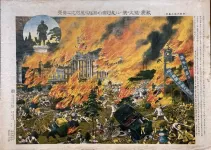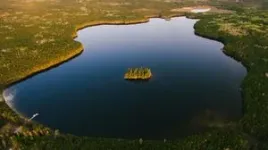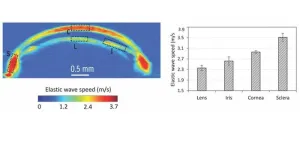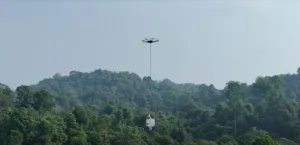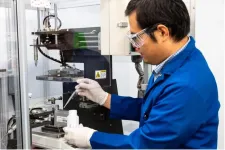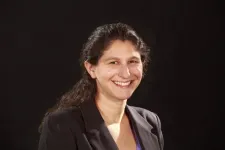(Press-News.org) Fires that raged in the days following the 1 September 1923 magnitude 7.9 Kantō earthquake killed roughly 90% of the 105,000 people who perished in and around Tokyo, making it one of the deadliest natural disasters in history—comparable to the number of people killed in the World War II atomic bombing of Hiroshima.
The story of the conflagration, not well-known outside of Japan, holds important lessons for earthquake scientists, emergency response teams and city planners, according to a new paper published in the Bulletin of the Seismological Society of America. The paper is part of an upcoming BSSA special issue on the 1923 Kantō earthquake.
The fires—which were foreseen and foretold by a contemporary seismologist—led to the first lessons in earthquake protection for schoolchildren in Japan after the earthquake. More recently, the history of earthquake-related fires in Japan has led to seismic shutoff valves being placed on gas meters throughout the country.
The threat of earthquake conflagrations has not disappeared. The authors say places with strong seismic shaking and a large inventory of wood-framed buildings-- the U.S. West Coast including Los Angeles, San Francisco and Seattle, Japan and parts of New Zealand—must emphasize fire prevention and response as part of their earthquake mitigation plans.
The researchers found that fewer than 5% of the literature written about the 1923 Kantō earthquake discusses the fire in detail, despite that fact that fire storms caused the majority of damage and deaths compared to severe ground shaking and liquefaction. Recent calculations put the fire losses at a total of almost ¥ 1.5 billion. For comparison, Japan’s total national budget for 1923 was ¥ 1.37 billion.
For these reasons, the authors say, the event should be known as Kantō Daikasai or the Great Kantō Fire Disaster instead of the more common name of Kantō Daishinsai or Great Kantō Earthquake Disaster.
Foreseen and Foretold
The conflagration following the earthquake had been envisioned in 1905 by Imamura Akitsune, an assistant professor of seismology at Tokyo Imperial University. He theorized a seismic gap in the region and suggested a large earthquake was due. He warned that citizens of Tokyo would have no place to shelter from fires triggered by such an earthquake. He suggested measures such as abolishing kerosene lanterns and creating setbacks between new buildings to lessen the danger.
Imamura’s warnings, however, were ridiculed by Japan’s leading seismologist at the time, Ōmori Fusakichi, a senior colleague, who did not believe in the seismic gap theory. Ōmori also thought earthquakes rarely took place in stormy or windy weather, so there would not be enough wind to cause fires to spread.
The Kantō earthquake occurred two minutes to noon on 1 September, when many citizens were lighting traditional kamado cooking stoves and shichirin and hibachi grills to cook a midday meal. Ground shaking toppled many of these, and within the first hour after the earthquake there were one hundred fires across the city – “a city largely built up of cheek-by-jowl light wood and paper housing,” said Charles Scawthorn, a researcher at the Pacific Earthquake Engineering Research Center, University of California at Berkeley.
“Under ordinary circumstances, the Tokyo fire department would not have been able to address all these fires, but compounding the situation were hundreds of breaks in the water mains, so that firefighters were largely powerless,” said Scawthorn, co-author of "Fire Following Earthquake".
The fires merged until some were so large that they generated their own high winds, turning into fire whirls or cyclones that consumed everything in their path.
In the BSSA paper, Tomoaki Nishino of the Disaster Prevention Research Institute at Kyoto University helped to explore the big picture of the fires including wind-blown fire plumes and model the spread of the fires, especially their relationship to wind direction and velocity. Nishino also looked at how an urban fire might spread in Kyoto City after a possible magnitude 7.5 scenario earthquake along the Hanaore fault.
“Large fires after an earthquake depend not only on the strength of the shaking, but on other conditions like the weather and built environment,” Nishino explained. “If the area consists of many fire-resistant buildings, or a low density of buildings, the conflagrations would not occur.”
“The collection of those conditions is less frequent than strong shaking, so the devastating regional impact of fires following earthquakes is less frequent compared to that of earth shaking,” he added. “But there can be a time when the number of simultaneous fires overwhelms firefighting capabilities.”
History Lessons
The BSSA authors also discuss the profound impact of the conflagration on urban planning, politics and education in Japan in the years following the destruction. Janet Borland, a historian at the International Christian University in Tokyo, became interested in studying the Kantō earthquake and fire after experiencing the 1995 Hanshin-Awaji or Kobe earthquake as an exchange student. She is the author of "Earthquake Children: Building Resilience from the Ruins of Tokyo", detailing the impacts of the 1923 event on children and education.
Borland has collected more than 2000 firsthand accounts of the event written and illustrated by children. “They give us a really valuable insight into the individual experiences of this catastrophic event in Japanese history, all across Tokyo,” she said, “of children who experienced fires, who watched parents drown in the Sumida River, or who were on the outskirts of the city and saw all these refugees evacuating.”
Imamura “invested so much as a seismologist in public education” after 1923, including pushing for the very first earthquake safety lesson in the Japanese school curriculum, Borland said. “He convinced the Ministry of Education officials, ‘we’re an earthquake nation, we need to teach our children what to do when an earthquake strikes.’”
Charles Schencking, a historian at the University of Hong Kong, began studying the Kantō event by looking at “how the elites interpreted the disaster, how they attempted to use the disaster to not only rebuild the capital but to reconstruct the nation on a social or ideological level,” he said.
But Schencking, author of "The Great Kantō Earthquake and the Chimera of National Reconstruction in Japan", also was drawn to the variety of stories about how people survived those terrible days.
“The harrowing personal accounts and the emotiveness of the material just drew me in and helped me become a different kind of historian,” he said. “The broad range of approaches you could take to learn about society by studying a disaster and the response that follows is to me immensely rewarding.”
“Imamura foresaw and foretold – science can warn, but economics, politics and resources must be mobilized if a warning is to have any effectiveness,” Scawthorn said.
END
Largest historic fire death toll belongs to aftermath of 1923 Japan Earthquake
2023-09-13
ELSE PRESS RELEASES FROM THIS DATE:
Nature’s great survivors: Flowering plants survived the mass extinction that killed the dinosaurs
2023-09-13
A new study by researchers from the University of Bath (UK) and Universidad Nacional Autónoma de México (Mexico) shows that flowering plants escaped relatively unscathed from the mass extinction that killed the dinosaurs 66 million years ago. Whilst they suffered some species loss, the devastating event helped flowering plants become the dominant type of plant today.
There have been several mass extinctions in the Earth’s history, the most famous caused by an asteroid hit 66 million years ago, which has steered the course of life on Earth profoundly.
The ...
Death rates following first heart attack have gone down for those without diabetes or with type 2 diabetes, but not for type 1 diabetes
2023-09-13
*Note- this is an early release from the Annual Meeting of the European Association for the Study of Diabetes (EASD) meeting in Hamburg, October 2-6. Please credit the meeting if you use this story*
New research to be presented at this year’s Annual Meeting of the European Association for the Study of Diabetes (EASD) in Hamburg, Germany (2-6 October) shows that, following a heart attack, there have been falls in the death rates of both people without diabetes and those with type 2 diabetes, but not those with type 1 diabetes. The study is by Dr Linn ...
University of Alberta to offer pioneering AI education to all undergraduate students
2023-09-12
The University of Alberta (U of A), a globally recognized leader in Artificial Intelligence (AI) and Machine Learning, along with Amii (Alberta Machine Intelligence Institute), are breaking new ground with the launch of "Artificial Intelligence Everywhere," a new online introductory course accessible to all U of A undergraduates. The course is the cornerstone for an in-development AI certification, which will be one of the first in Canada.
The course equips students across all disciplines with essential AI literacy skills. With AI permeating sectors from health care to finance, this initiative bridges the AI skills ...
Making mammography inclusive for patients with disabilities
2023-09-12
Lene Andersen, MSW, has been living with rheumatoid arthritis and disability since childhood. Her personal experience with limited mobility and the challenges faced in accessing mammography screening in Toronto, Ontario, has fueled her determination to advocate for change. Her story is featured in an upcoming themed issue of the Journal of Medical Imaging and Radiation Sciences on the topic of specialized populations, published by Elsevier.
In this personal narrative, Lene, an advocate and accessibility consultant, teamed up with Natasha Batchelor, MHSc, MRT(R), a medical imaging technologist from the York region in Ontario with expertise in creating an accessible mammography ...
New imaging technique measures elasticity of multiple eye components simultaneously
2023-09-12
The eye is a highly complex organ, composed of intricate structures combining several types of specialized tissues. Under normal conditions, these structures work seamlessly together to provide clear images of the world around us as well as maintain intraocular pressure. However, when ocular diseases set in, the biomechanical properties of eye components change, disrupting their normal functioning. Most importantly, the alternations in biomechanical properties of the eye often lead to significant ocular diseases and vision loss. In order to study, diagnose, and monitor ocular diseases, it is, therefore, ...
Novel emerging nano-assisted anti-cancer strategies based on the STING pathway
2023-09-12
https://www.scienceopen.com/hosted-document?doi=10.15212/AMM-2023-0023
Announcing a new publication for Acta Materia Medica journal. Activation of simulator of interferon genes (STING), which induces the production of proinflammatory factors and immune effector cell activation, is considered a promising strategy for enhanced anti-cancer intervention. However, several obstacles prevent STING signaling in solid tumors, such as delivered molecules’ rapid degradation, restriction to tumor sites, insufficient intracellular concentrations, and low responsivity. ...
'Team Waponi' advances to finals of $10M XPRIZE Rainforest Competition with 'Limelight', earns $300K semi-finalist prize
2023-09-12
NJIT biology professor Eric Fortune and a team of scientists, known as “Team Waponi”, have reached the final stage of the five-year, $10M XPRIZE Rainforest Competition.
In June, Fortune and 13 other team members traveled to the rainforests of Singapore to compete in the semi-finals of the global competition, which challenged teams to develop and demonstrate new technologies for mapping the vast biodiversity of the world's tropical forests.
The team’s biodiversity sampling device, called “Limelight”, has captured exactly that so far — securing them a spot among six finalists to advance from the field of 13 teams, while earning ...
Charging ahead: New electrolyte goes extra mile for faster EV charging
2023-09-12
Oak Ridge National Laboratory researchers are taking fast charging for electric vehicles, or EVs, to new extremes.
A team of battery scientists recently developed a lithium-ion battery material that not only recharges 80% of its capacity in 10 minutes but keeps that ability for 1,500 charging cycles.
When a battery operates or recharges, ions move between electrodes through a medium called the electrolyte. ORNL’s Zhijia Du led a team who developed new formulations of lithium salts with carbonate solvents to form an electrolyte that maintains better ion flow over time and performs well when high current heats up the battery ...
Smartphone technology expected to advance assessment of neurological soft signs in schizophrenia
2023-09-12
September 12, 2023 — Since the 1980s, we have known that neurological soft signs (NSS) can distinguish people with schizophrenia from psychiatrically healthy individuals. NSS are subtle neurological impairments that principally manifest as decreased sensory integration (trouble receiving and responding to information transmitted to the brain through the senses) and difficulties with balance, rapid successive movements, and right–left orientation.
NSS doesn't always cause impairment of daily living, but identifying them could improve the diagnosis and treatment of schizophrenia and enhance understanding of the ...
Kessler Foundation receives $725,000 grant for study to accelerate functional recovery in multiple sclerosis
2023-09-12
East Hanover, NJ – September 12, 2023 – Carly Wender, PhD, associate research scientist in the Center for Neuropsychology and Neuroscience Research at Kessler Foundation received a three-year $725,499 grant from the National Multiple Sclerosis Society for her study, “A Novel Combinatory Approach to Maximize Functional Recovery of Learning and Memory in Multiple Sclerosis.”
Cognitive impairment is a common symptom in individuals with multiple sclerosis (MS) that can be particularly ...
